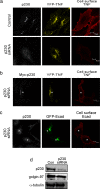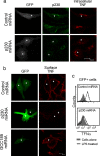A trans-Golgi network golgin is required for the regulated secretion of TNF in activated macrophages in vivo
- PMID: 18308930
- PMCID: PMC2265200
- DOI: 10.1073/pnas.0800137105
A trans-Golgi network golgin is required for the regulated secretion of TNF in activated macrophages in vivo
Abstract
The transmembrane precursor of tumor necrosis factor-alpha (TNF) exits the trans-Golgi network (TGN) in tubular carriers for subsequent trafficking and delivery to the cell surface; however, the molecular machinery responsible for Golgi export is unknown. We previously reported that members of the TGN golgin family are associated with subdomains and tubules of the TGN. Here, we show that the TGN golgin, p230/golgin-245 (p230), is essential for intracellular trafficking and cell surface delivery of TNF in transfected HeLa cells and activated macrophages. Live-cell imaging revealed that TNF transport from the TGN is mediated selectively by tubules and carriers marked by p230. Significantly, LPS activation of macrophages resulted in a dramatic increase of p230-labeled tubules and carriers emerging from the TGN, indicating that macrophages up-regulate the transport pathway for TNF export. Depletion of p230 in LPS-stimulated macrophages reduced cell surface delivery of TNF by >10-fold compared with control cells. To determine whether p230 depletion blocked TNF secretion in vivo, we generated retrogenic mice expressing a microRNA-vector to silence p230. Bone-marrow stem cells were transduced with recombinant retrovirus containing microRNA constructs and transplanted into irradiated recipients. LPS-activated peritoneal macrophages from p230 miRNA retrogenic mice were depleted of p230 and had dramatically reduced levels of cell surface TNF. Overall, these studies have identified p230 as a key regulator of TNF secretion and have shown that LPS activation of macrophages results in increased Golgi carriers for export. Also, we have demonstrated a previously undescribed approach to control cytokine secretion by the specific silencing of trafficking machinery.
Conflict of interest statement
The authors declare no conflict of interest.
Figures




Similar articles
-
E-cadherin transport from the trans-Golgi network in tubulovesicular carriers is selectively regulated by golgin-97.Traffic. 2005 Dec;6(12):1142-56. doi: 10.1111/j.1600-0854.2005.00349.x. Traffic. 2005. PMID: 16262725
-
Rab6a/a' are important Golgi regulators of pro-inflammatory TNF secretion in macrophages.PLoS One. 2013;8(2):e57034. doi: 10.1371/journal.pone.0057034. Epub 2013 Feb 21. PLoS One. 2013. PMID: 23437303 Free PMC article.
-
Mammalian GRIP domain proteins differ in their membrane binding properties and are recruited to distinct domains of the TGN.J Cell Sci. 2004 Nov 15;117(Pt 24):5865-74. doi: 10.1242/jcs.01497. Epub 2004 Nov 2. J Cell Sci. 2004. PMID: 15522892
-
The formation of TGN-to-plasma-membrane transport carriers.Annu Rev Cell Dev Biol. 2006;22:439-55. doi: 10.1146/annurev.cellbio.21.012704.133126. Annu Rev Cell Dev Biol. 2006. PMID: 16824007 Review.
-
Domains of the TGN: coats, tethers and G proteins.Traffic. 2004 May;5(5):315-26. doi: 10.1111/j.1398-9219.2004.00182.x. Traffic. 2004. PMID: 15086781 Review.
Cited by
-
Multiple TLRs elicit alternative NLRP3 inflammasome activation in primary human monocytes independent of RIPK1 kinase activity.Front Immunol. 2023 Oct 26;14:1092799. doi: 10.3389/fimmu.2023.1092799. eCollection 2023. Front Immunol. 2023. PMID: 37954581 Free PMC article.
-
PKD-dependent PARP12-catalyzed mono-ADP-ribosylation of Golgin-97 is required for E-cadherin transport from Golgi to plasma membrane.Proc Natl Acad Sci U S A. 2022 Jan 4;119(1):e2026494119. doi: 10.1073/pnas.2026494119. Proc Natl Acad Sci U S A. 2022. PMID: 34969853 Free PMC article.
-
Mapping localization of 21 endogenous proteins in the Golgi apparatus of rodent neurons.Sci Rep. 2023 Feb 18;13(1):2871. doi: 10.1038/s41598-023-29998-8. Sci Rep. 2023. PMID: 36806293 Free PMC article.
-
Alcohol-induced Golgiphagy is triggered by the downregulation of Golgi GTPase RAB3D.Autophagy. 2024 Jul;20(7):1537-1558. doi: 10.1080/15548627.2024.2329476. Epub 2024 Apr 9. Autophagy. 2024. PMID: 38591519 Free PMC article.
-
The golgin coiled-coil proteins of the Golgi apparatus.Cold Spring Harb Perspect Biol. 2011 Jun 1;3(6):a005256. doi: 10.1101/cshperspect.a005256. Cold Spring Harb Perspect Biol. 2011. PMID: 21436057 Free PMC article. Review.
References
-
- Hume DA. The mononuclear phagocyte system. Curr Opin Immunol. 2006;18:49–53. - PubMed
-
- Beutler BA. The role of tumor necrosis factor in health and disease. J Rheumatol. 1999;57:16–21. - PubMed
-
- Siddiqui MA, Scott LJ. Infliximab: a review of its use in Crohn's disease and rheumatoid arthritis. Drugs. 2005;65:2179–2208. - PubMed
-
- Murray RZ, Kay JG, Sangermani DG, Stow JL. A role for the phagosome in cytokine secretion. Science. 2005;310:1492–1495. - PubMed
Publication types
MeSH terms
Substances
LinkOut - more resources
Full Text Sources
Other Literature Sources
Molecular Biology Databases
Miscellaneous

